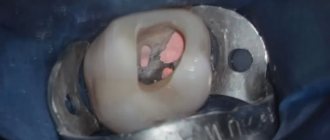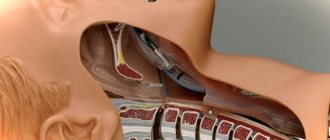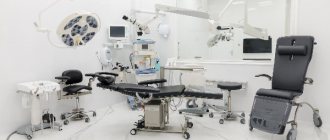Many people are afraid of anesthesia. And many are hesitant to undergo knee arthroscopy, being sure that it is performed under anesthesia. But if you understand the medical terminology, it turns out that this is not so. Intrigued? Well, then let's figure it out.
Looking in any dictionary of medical terms, you will read that anesthesia is a deliberate inhibition of the central nervous system (CNS), the purpose of which is to “disconnect” the patient from the feeling and awareness of pain impulses. That is, for example, the effect on the patient’s brain with special drugs. In this case, an artificial coma occurs, muscles relax, some reflexes turn off and pain sensitivity disappears.
Anesthesia involves completely putting a person to sleep in order to turn off the central nervous system. However, not every patient is put to sleep during arthroscopy. Anesthesia is used only in special cases. And most arthroscopic interventions are performed under local, spinal and conduction anesthesia. These types of pain relief do not require “switching off consciousness”, so they frighten patients less.
Why is anesthesia needed for knee arthroscopy?
Anesthesia is a general concept that refers to the process of suppressing pain sensitivity with the help of drugs. It is necessary to relieve a person from pain, stress and discomfort during surgery.
Anesthesiologists distinguish several types of anesthesia:
- General (anesthesia) - effects on the central nervous system, the brain and consciousness of a person. Anesthetics are administered intravenously or by inhalation, through a laryngeal tube or mask.
- Spinal and epidural - blockade of the nerve roots that innervate the lower extremities. Painkillers are injected into the spine, at the level of the spinal cord.
- Conductor (regional) - involves blocking the nerve trunks and nerve plexuses, which are located above the operation site. Arthroscopy usually involves blocking the femoral and sciatic nerves.
- Local (infiltration) - blockade of sensory receptors of peripheral nerves. It involves the infiltration of periarticular tissues with anesthetics, as well as their introduction into the joint cavity.
Different types of anesthesia differ in strength, degree of analgesic and muscle relaxant effect. When choosing an anesthesia method, a number of factors are taken into account: the patient’s age, his state of health, the presence of concomitant diseases, the degree of trauma and pain of arthroscopic intervention, etc.
Operating principles
Anesthesia is carried out immediately before the start of treatment. The anesthetic comes in both liquid and gel form. The doctor injects into the soft tissues that are located near the diseased tooth. After some time, the tongue, gums and cheeks become numb and “freeze”. At this moment, the anesthetic acts as a blocker of nerve impulses that send a pain signal to the brain. The patient calmly endures dental procedures without experiencing stress.
The duration and effectiveness of dental anesthesia depends on the quality of the materials used and the location of the injection. The closer to the problem area the injection was administered, the more intense its effect. Each organism is individual, therefore the drug will be excreted at different rates.
Different types of drugs function in their own ways. For example, gel-like ones applied to the gums or surface of the cheek last only a couple of minutes. If they are installed in the upper part of the jaw, the effect will last for 2-3 hours. To treat the lower group of teeth, a deeper injection is required, so the result lasts up to 4 hours. After the solution is absorbed, the numbness disappears and sensitivity returns to the patient.
General rules of anesthesiology
Adequate pain relief is an important condition for restoring limb function after surgery. Therefore, certain requirements are imposed on anesthesia during arthroscopic operations.
The main ones:
- sufficient intraoperative pain relief;
- adequate pain relief in the early postoperative period;
- minimal impact on the muscle tone of the operated limb.
It is extremely important that the patient maintains muscle strength and muscle tone in the lower extremity after surgery. This is necessary for early loading of the leg (full or dosed). If muscle strength is maintained, the person begins to walk soon after surgery, which allows him to be discharged from the hospital faster.
Anesthesia for children
Painless pediatric dentistry is a hot topic today. All parents know what a trip to the dentist means for a child. If this brings few pleasant emotions to an adult, then what can we say about children. The first scheduled visit is always scheduled for the age of 6-7 years - this is the time when baby teeth are replaced with permanent ones.
The psyche of children is not yet fully formed; one wrong word or action can provoke the development of unpleasant memories. Therefore, it is important to instill confidence in the child, to mentally prepare him for the procedure: explain why he is going there and what the doctor will do. The use of anesthetic agents in pediatric dentistry is an integral part of comfortable treatment.
The most suitable injection methods for babies are infiltration, conduction and application. The place where the drug is administered is “frozen” in advance and only then does the doctor give an injection. The child’s body is not yet fully formed, so in pediatric anesthesia, special medications are used that make it possible to carry out the procedure safely.
Features of different types of anesthesia
For intraoperative pain relief, various methods of general, regional and local anesthesia, as well as their combinations, are used. Each of them has a number of disadvantages and advantages.
Local
From a technical point of view, local anesthesia is the simplest. Even a traumatologist can perform local administration of anesthetics without the help of an anesthesiologist. However, such anesthesia does not always provide a sufficiently strong analgesic effect. And its quality largely depends on the practical skills of the traumatologist.
Conductor
It is one of the best options for pain relief during arthroscopic interventions on the knee joint. It is technically more complex than local, and therefore requires great skill of the anesthesiologist. The doctor must have a good knowledge of the structure of the peripheral nervous system, master the technique of blocking nerves at different levels, and be able to use special instruments to perform a femoral / sciatic nerve block.
Conduction anesthesia provides long-term pain relief during movement of the lower limb and thereby improves the course of the early postoperative period. However, due to technical difficulties, it is still less common than spinal.
Spinal
Guarantees adequate postoperative pain relief and early restoration of muscle tone. However, a number of complications can occur, including spinal cord or root injuries, radiculopathy, cauda equina syndrome, seizures, etc. The high incidence of side effects (back pain, headaches, hypotension) often reduces patient satisfaction with the quality of such pain relief.
Anesthesia
It is rarely used during arthroscopy, usually in one-day hospitals. Modern intravenous and/or inhalational anesthetics can be used for anesthesia. During surgery, the patient often breathes independently through a laryngeal mask. For special indications, he may undergo artificial pulmonary ventilation (ALV).
Anesthesia has its advantages:
- safety;
- good handling;
- minimal number of side effects;
- no effect on the muscle tone of the limb in the postoperative period;
- possibility of rapid discharge from hospital.
At the same time, anesthesia does not always provide adequate postoperative pain relief. Therefore, in the early stages after arthroscopy, the patient may be additionally administered anesthetics.
Anesthesia for rhinoplasty
When performing rhinoplasty, it is important that the surgical procedure is as painless as possible.
The Dr. Alexander Markushin Rhinoplasty Center uses only modern, proven anesthesia methods.
The plastic surgeon planning the operation, after a careful examination, obtaining laboratory results, choosing a technique, and the anesthesiologist determine what type of anesthesia will be used for rhinoplasty.
Important!!!
The method of anesthesia for a specific operation is chosen by the attending physician and anesthesiologist, having familiarized themselves in detail with the test results, the presence of chronic diseases or possible allergic reactions.
Types of anesthesia used for rhinoplasty
Depending on the complexity of the upcoming operation and the individual characteristics of the patient’s body, the type of anesthesia is selected.
In total, three main methods of pain relief are used during nasal surgery.
- Endotracheal anesthesia.
- Local anesthesia.
- Intravenous method of pain relief.
Each technique has its own strengths and weaknesses, which makes it possible to combine them in case of emergency with other types of anesthesia.
Local anesthesia for rhinoplasty
The technique is used for minor operations designed to slightly correct the relief or shape of the nose. In addition, it is always used as an adjunct to general anesthesia, as well as independently if there are medical contraindications to general anesthesia.
Correction of the tip of the nose, removal or straightening of the hump can be performed under local anesthesia.
The tissues exposed to the surgeon are infiltrated with local anesthetics.
Deep infiltration blocks the passage of signals along nerve fibers, making the operation painless.
However, there are no restrictions for tactile or temperature impulses.
Important to remember!!!
Injections of lidocaine, marcaine or xylocaine are mainly used. Before this, an allergic reaction test may be performed to ensure that there is no allergy to the medications used. Otherwise, anaphylactic shock may occur.
For the following contraindications, local anesthesia should not be used:
- increased psychomotor excitability of the patient;
- negative reaction of the body to the use of a local drug;
- any type of mental disorder;
- chronic diseases of the cardiovascular or respiratory system during exacerbation.
For some patients, local anesthesia is not an option because it is difficult to watch the doctor cut facial tissue during surgery. Even a mentally stable person finds it difficult to remain calm without moving when he watches his nose get cut. Therefore, in common practice, a small amount of sedatives is administered during rhinoplasty under local anesthesia.
General anesthesia during nasal surgery
A plastic surgeon and an anesthesiologist choose general anesthesia for a complex, multifaceted operation or correction of serious defects received in an accident, during sports competitions, with burns of a large surface of the face, etc. The good thing about this method is that the patient is unconscious during anesthesia and does not feel any pain.
Before such operations, it is imperative to consult an experienced anesthesiologist so that problems do not arise during the surgeon’s work and after recovery from anesthesia. The patient must strictly follow all the doctor’s recommendations for rhinoplasty to be perfect.
Premedication
For some people, going under anesthesia is scarier than the surgery itself. To help such a patient, sedatives, antihistamines, and a tranquilizer can be administered intravenously half an hour before rhinoplasty. The dosage and time are prescribed by the anesthesiologist.
The patient must strictly follow the instructions received. Here it is important to maintain exact proportions, taking into account body weight and individual characteristics of the body. The drugs will not only calm you down, they will reduce the secretory function of biological fluids by the glands. This is very important during nose surgery.
Preoperative nutrition
A special diet will prepare the body for the upcoming stress. It is best if you have a full meal the day before rhinoplasty, and six to eight hours before you can have a small snack. Drinks can be consumed 6 hours before surgery.
During general anesthesia, this is an important precaution because vomiting can throw food debris into the lungs. A patient under general anesthesia cannot control internal processes because the muscles are relaxed and the sphincters are not able to delay the movement of juices from the stomach and intestines. Hydrochloric acid entering the lungs from the stomach can be fatal. Therefore, strict adherence to nutritional rules before surgery is an important part of patient preparation.
Intravenous anesthesia for rhinoplasty
The drugs are injected into a vein to quickly block the areas of the brain responsible for the perception of pain impulses. The calculation of the required amount of the drug is performed only by a highly qualified anesthesiologist, taking into account the concentration of the drug based on the patient’s weight.
The main advantage of intravenous anesthesia is the immediate effect of drugs. At the same time, the plastic surgeon must remember that the effect of anesthesia is strictly limited in time. It is necessary to carefully monitor how sensitivity changes so that, if necessary, administer another dose.
During the entire operation and after it, the patient is in the clinic under round-the-clock supervision of an anesthesiologist, who is ready to provide assistance in the event of any conditions that threaten the life and health of the patient.
Endotracheal anesthesia for rhinoplasty
Complex anesthesia with prolonged action is ideal for complex, lengthy operations.
- At the first stage, the patient is given special medications intravenously.
- Then he is intubated (a special tube is inserted into the trachea) to ensure an uninterrupted supply of the required amount of air.
The procedure itself resembles a complex operation and is therefore performed only by qualified, specially trained personnel.
The main advantages of this method of anesthesia include:
- the possibility of free flow of oxygen into the lungs, necessary for the normal functioning of the body;
- getting the medicine exactly into the trachea allows you to select the required dose as accurately as possible;
- the maximum permissible level of oxygen in the blood can be accurately maintained to avoid pulmonary or heart failure;
- gastric juice will definitely not get into the lung tissue;
- a completely immobilized, unconscious patient allows the plastic surgeon to perform any manipulations without fear.
This anesthesia technique is ideal for rhinoplasty operations. The patient's condition is constantly monitored. If necessary, emergency measures can be taken immediately.
However, there are a number of contraindications for which endotracheal anesthesia is not used.
- Chronic diseases of the lungs, bronchi or tuberculosis in any form.
- Hemorrhagic diathesis.
- Acute inflammatory processes in the lungs or bronchi.
Important!!!
The presence of any neoplasms on the tissue of the soft palate or near the root of the tongue requires the use of a tracheostomy to avoid possible pathologies.
What complications can you encounter after anesthesia?
Regardless of the chosen method of anesthesia, each person’s body reacts individually to interference in its work. Therefore, you should be prepared for minor complications in order to immediately eliminate the negative consequences.
Possible complications are:
- A sharp drop in body temperature.
- If the dose of the medicine is incorrectly chosen, interruptions in the functioning of the heart may occur.
- If stomach contents reflux into the lungs, resuscitation should begin immediately.
- The onset of profuse vomiting, provoked by the action of medications.
- Damage to peripheral nerve endings.
- Injury to soft tissues of the respiratory tract during intubation.
The doctor reacts instantly to any negative consequences of anesthesia, so the risk of serious complications is minimal.
Dr. Alexander Aleksandrovich Markushin has performed thousands of operations of varying complexity with consistently high results.
Modern medicine provides almost one hundred percent guarantees that there will be no negative effects on the body after anesthesia.
Most often, myths circulating among people are born from tales that came from the last century, when painkillers were not so perfect.
Having followed all the doctor’s instructions to prepare for the operation, you don’t have to worry that there will be serious difficulties in recovering from anesthesia. A qualified anesthesiologist is always present at each operation in order to immediately correct the work if necessary.
Individual work with each patient eliminates even minimal danger.
Choosing a pain relief method
Today, most arthroscopic interventions are performed under spinal anesthesia. For short-term operations, a 2% lidocaine solution is injected into the patient's subarachnoid space. For arthroscopy lasting more than 1.5 hours, a 0.5% solution of isobaric or hyperbaric spinal marcaine is used. Note that spinal anesthesia can cause hemodynamic complications if the patient is hypovolemic. Therefore, in gerontological patients, an epidural is often used instead.
In recent years, diagnostic and therapeutic arthroscopy has increasingly been performed under general anesthesia. It is less expensive, less likely to cause side effects, and produces greater satisfaction among patients and trauma surgeons.
In emotionally labile patients, intravenous anesthesia with mechanical ventilation or spontaneous breathing through a laryngeal mask is often used.
Local anesthesia is used only for low-pain arthroscopic interventions, for example, when removing foreign bodies from the joint cavity. “Classical” anesthesia with intubation and muscle relaxation is also used extremely rarely, only if there are special indications.
What ophthalmic surgeries require anesthesia?
The choice of anesthesia is directly related to the volume of the planned intervention. Anesthesia is used for almost all types of ophthalmological operations. These include: extraocular, intraocular and mixed interventions.
- Extraocular surgeries include tear duct interventions and strabismus correction surgeries.
- Intraocular interventions include cataract surgery and retinal surgery.
- Antiglaucomatous interventions and drainage of the eyeball are considered to be mixed operations.
Anesthesia is also used during operations for eye injuries. The volume of intervention determines the amount of damaged tissue of the organ of vision.
Contraindications
The greatest number of contraindications exist for general anesthesia. When administered systemically, anesthetic drugs can negatively affect internal organs. Therefore, anesthesia is contraindicated for arrhythmias, heart defects, bronchial asthma, bleeding disorders, renal, hepatic and cardiovascular failure.
Contraindications to spinal and epidural anesthesia may include infection at the injection site and allergy to anesthetics. These types of pain relief will not be used even if there are no contraindications. This is possible if the patient himself refuses them.
Features of pain relief in pregnant women
One of the most common misconceptions is that pregnant women are contraindicated for dental treatment. You should not trust unreliable sources; dentistry and pregnancy are completely compatible concepts. Expectant mothers should undergo a professional examination during planning and at 8, 18 and 28 weeks of pregnancy. Untreated infections in the oral cavity contribute to the development of other dangerous diseases.
The question immediately arises: can the use of dental anesthesia harm the health of the unborn child? Modern technologies allow the use of drugs with lower concentrations of adrenaline. Accepted painkillers are ultracaine, primacaine or mepivacaine*. They do not penetrate the placenta, therefore, do not harm the body of a pregnant woman.
*A verified and accurate list of acceptable medications can be obtained from your doctor.
What happens if cataracts are not treated?
Cataracts will inevitably progress, even with the use of the most modern medications. Degenerative processes will lead to disruption of the structure of the lens, its clouding and delamination. Eventually, the cataract will enter an overripe stage, when the fibers of the lens disintegrate, its cortex liquefies, the nucleus loses support and sinks down. The result is complete blindness. In addition, complications are possible, for example, the development of glaucoma due to occlusion of the outflow tract of intraocular fluid, or rupture of the lens capsule and release of detritus with the development of the inflammatory process.
When should cataract surgery be performed?
Radical treatment of cataracts is possible only surgically - the lens is removed and replaced with an artificial one. Modern technologies make it possible to perform the procedure without waiting for the cataract to mature, which allows you to preserve vision. Indications for surgery are the following factors:
- Intumescent cataract;
- Mature and overmature cataracts;
- Subluxation or complete dislocation of the lens;
- Presence of concomitant eye pathology;
- Persistent decrease in vision.
Cataract treatment
In the early stages, conservative treatment is carried out using drugs in the form of drops to restrain the progression of the process. The drops contain substances that either increase the energy level of functioning of the lens structures or protect them from the harmful effects of products of impaired metabolism of amino acids such as tryptophan and tyrosine. However, the main method of treatment remains surgical. Extraction (or extraction) of the cloudy lens from the eye cavity. Today, the optimal operation is cataract extraction through a small (from 1.5 to 3.5 mm) incision with simultaneous implantation of a foldable IOL (intraocular lens) made of a hydrophobic polymer material with shape memory into the capsular bag of the lens. Ultrasound energy is used in combination with the impact of a sound wave to destroy the nucleus of the lens. Make an appointment
Symptoms of cataracts
Symptoms depend on the stage of the disease. At the initial stage, there may not be any subjective manifestations. At the stage of immature cataracts, vision deterioration is observed. Patients may experience double vision, blurred images, and a yellow coloration. Sensitivity to bright light increases, while at the same time twilight vision decreases. Many patients use bright light to read or work with fine details. Myopia develops or progresses, which cannot be corrected with glasses. At the stage of mature cataract, all symptoms worsen, and at the stage of overmature cataract, complete blindness occurs, up to loss of light perception.











